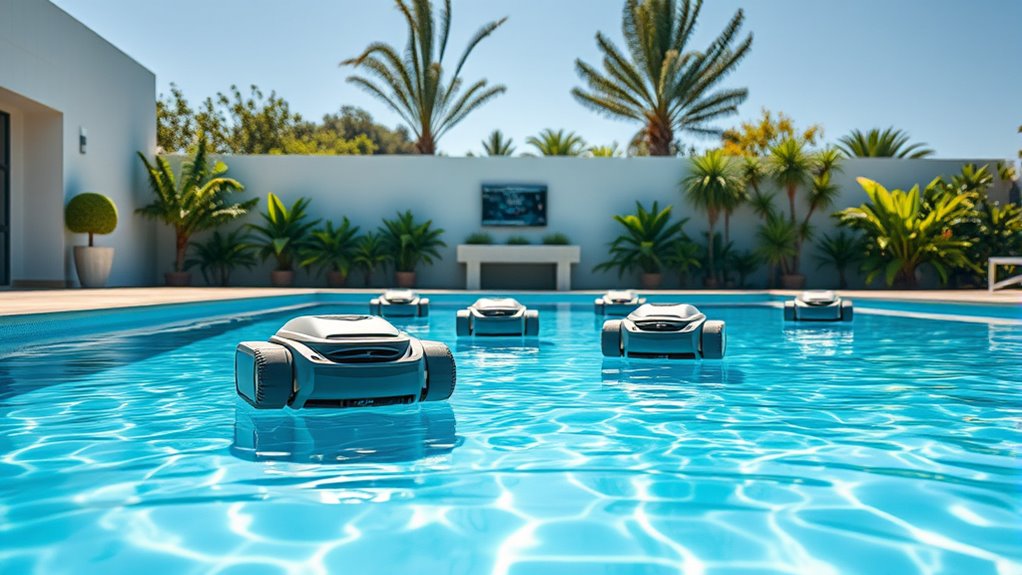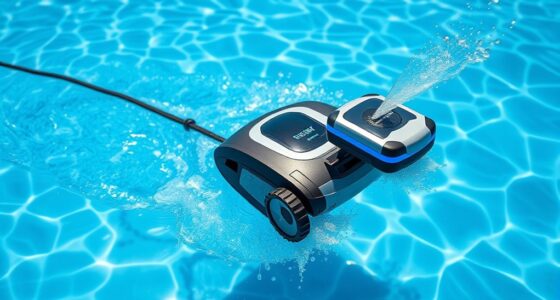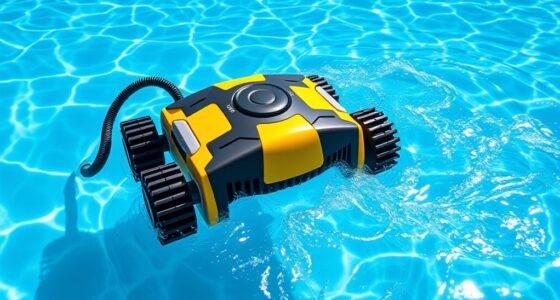The automatic pool cleaners industry is growing rapidly as more homeowners seek convenient, efficient ways to maintain their pools. Innovations like smart navigation, eco-friendly features, and diverse models cater to different needs and budgets. Major brands focus on improving durability, water filtration, and user control. With evolving technology and consumer preferences, the industry offers numerous opportunities. Exploring more will reveal how these trends shape the future of pool cleaning solutions.
Key Takeaways
- The industry is growing rapidly due to increasing demand for efficient, automated pool maintenance solutions.
- Major types include suction-side, pressure-side, and robotic cleaners, each offering different features and functionalities.
- Technological innovations incorporate smart navigation, remote control, and advanced debris filtration for improved performance.
- Leading brands like Dolphin, Zodiac, and Hayward focus on durability, efficiency, and user-friendly designs.
- Market growth is driven by consumer preferences for eco-friendly features, affordability, and integration with smart home devices.
Market Overview and Growth Drivers

The automatic pool cleaners industry is experiencing significant growth driven by increasing demand for convenient and efficient pool maintenance solutions. As more homeowners seek hassle-free ways to keep their pools clean, the market expands rapidly. The growth is fueled by innovations in technology, making cleaners more effective and user-friendly. Market segmentation plays a key role, with various product types targeting different customer needs and budgets. This diversity allows manufacturers to reach a broader audience and adapt to evolving consumer preferences. Additionally, rising disposable incomes and a growing trend toward home improvement boost sales further. Overall, the industry’s trajectory is strong, driven by a desire for simplified pool maintenance and a broader market that continues to evolve with consumer demands. Incorporating design thinking approaches can further enhance product development and user experience in this competitive industry.
Types of Automatic Pool Cleaners

Automatic pool cleaners come in three main types: suction-side, pressure-side, and robotic models, each designed to meet different cleaning needs and preferences. Suction-side cleaners connect to your pool’s skimmer or dedicated vacuum line, making them effective for routine pool maintenance. Pressure-side cleaners use a dedicated booster pump, providing better debris collection, especially in larger pools. Robotic models are self-contained units that operate independently, offering advanced features like programmable schedules and water safety sensors. Robots often incorporate advanced navigation systems that enable them to cover the entire pool surface efficiently. Some models also include filtering technology that helps trap even the smallest debris, improving overall water clarity. Choosing the right type depends on your pool’s size, debris level, and desired maintenance frequency. All three help maintain water safety by keeping the pool clean and free of contaminants, reducing health risks. Additionally, some Kia Tuning modifications can improve vehicle handling, which is beneficial when transporting cleaning equipment or accessories. Understanding these options guarantees you select a cleaner suited to your pool’s specific requirements, and considering the types of automatic pool cleaners can help you make an informed decision. For instance, the technology used in robotic cleaners often includes sensors and microprocessors to optimize cleaning paths and efficiency.
Key Manufacturers and Industry Leaders

Leading manufacturers and industry giants shape the landscape of automatic pool cleaners, driving innovation and setting standards for quality and performance. They influence how you approach pool maintenance and water filtration, ensuring cleaner, clearer water. Major players like Dolphin, Zodiac, Hayward, and Pentair lead the market with diverse product lines and reliable features. These companies focus on enhancing water filtration efficiency, durability, and ease of use, helping you maintain your pool effortlessly. Their products often include:
- Advanced navigation systems
- Powerful suction capabilities
- Energy-efficient designs
- Enhanced water filtration features which adhere to industry standards, ensuring products meet rigorous quality and safety benchmarks. These standards help consumers trust in the reliability and safety of their purchases. Incorporating innovative technologies such as smart sensors and automation further elevates their performance and user experience. Moreover, staying informed about regulatory frameworks helps consumers select products that comply with safety and environmental regulations.
Technological Innovations and Features

You’ll notice that modern pool cleaners now feature smart navigation systems that optimize cleaning paths. Advanced technologies improve efficiency and make certain of thorough coverage, saving you time and effort. Many models also integrate seamlessly with smart devices, giving you more control at your fingertips. Additionally, high-performance components ensure durability and consistent operation over extended use.
Smart Navigation Systems
Smart navigation systems have revolutionized the efficiency and effectiveness of pool cleaners by enabling them to map and adapt to complex pool layouts. With advanced smart navigation and obstacle detection, your cleaner can efficiently cover every inch of the pool, reducing missed spots and cleaning time. These systems use sensors and algorithms to create a virtual map, allowing your cleaner to plan ideal paths and avoid obstacles seamlessly. Key benefits include:
- Precise obstacle detection to prevent collisions
- Adaptive route planning for thorough cleaning
- Reduced cleaning time through efficient navigation
- Enhanced coverage of irregular pool shapes
- Color accuracy in sensors helps improve obstacle detection and mapping accuracy
Advanced Cleaning Technologies
Advanced cleaning technologies have substantially enhanced the performance of automatic pool cleaners by incorporating innovative features that target stubborn dirt and hard-to-reach spots. These innovations boost robotic efficiency, allowing cleaners to cover more surface area in less time. Modern models often include powerful suction systems and specialized brushes that effectively loosen debris, ensuring a thorough clean during each cleaning cycle. Some cleaners use advanced sensors to detect dirtier areas and adjust their cleaning pattern accordingly, optimizing efficiency. Additionally, improved navigation algorithms help avoid missed spots and reduce the overall cleaning time. As a result, your pool stays cleaner longer, with less manual intervention needed, thanks to these cutting-edge features that elevate the overall cleaning experience. Moreover, integrating advanced sensor technology can lead to even smarter cleaning patterns and better coverage. Utilizing smart navigation systems can further improve the precision and speed of cleaning, making these devices more effective and user-friendly. Continuous innovations in robotic automation are driving the industry toward more intelligent and efficient pool cleaning solutions.
Integration With Smart Devices
The integration of automatic pool cleaners with smart devices has revolutionized how you manage pool maintenance. With features like remote control, you can operate your cleaner from anywhere using your smartphone. This connectivity allows for real-time updates on cleaning progress and easy scheduling. Plus, smart integration enhances energy efficiency by optimizing cleaning cycles based on pool size and usage patterns. You can customize cleaning routines, reducing unnecessary operation and saving energy. Additionally, some cleaners automatically detect debris levels to adjust their activity, improving efficiency further.
- Seamless remote operation via apps
- Real-time status updates
- Customizable cleaning schedules
- Energy-efficient automatic adjustments
Consumer Preferences and Buying Trends

You’ll notice that eco-friendly features are increasingly influencing buying decisions, as consumers seek sustainable options. Price sensitivity also plays a significant role, with many shoppers balancing quality and affordability. Understanding these trends can help you choose a cleaner that aligns with your values and budget. Additionally, innovations like sound synthesis and immersive audio technologies are shaping how consumers experience and evaluate products in related industries. The rise of advanced algorithms in machine learning also contributes to smarter cleaning solutions that optimize performance and energy efficiency. Moreover, the importance of conflict resolution skills is gaining recognition as consumers look for reliable and trustworthy products, ensuring safety features and compliance with regulations are becoming critical considerations for consumers prioritizing reliability. As the industry adopts eco-friendly manufacturing processes, consumer preference for environmentally responsible products continues to grow.
Eco-Friendly Features Popularity
Are eco-friendly features gaining popularity in the automatic pool cleaners industry? Absolutely. Consumers are increasingly prioritizing sustainability, seeking products that reduce environmental impact. Many prefer cleaners with solar power capabilities, harnessing sunlight to operate efficiently without relying on traditional electricity. Water conservation is also a key concern; eco-friendly models often use less water or recycle filtered water. You’ll notice a shift toward features like biodegradable materials and energy-efficient motors. Proper insulation and ground loop optimization are critical for maximizing heat pump performance, which aligns with the growing consumer demand for energy-efficient and sustainable products. To summarize, the main reasons for this trend include:
- Solar-powered operation reduces electricity use
- Minimized water wastage through advanced filtration systems
- Use of eco-friendly, non-toxic cleaning agents
- Longer-lasting, sustainable materials
These factors reflect a growing consumer preference for eco-conscious choices in pool care.
Price Sensitivity Trends
Have consumer preferences shifted toward more budget-friendly automatic pool cleaners? Likely so, as increased consumer price sensitivity influences buying decisions. To stay competitive, manufacturers are adjusting their pricing strategies, offering models at various price points to attract cost-conscious buyers. This trend indicates that consumers are more willing to compare prices and seek value, rather than simply opting for premium options. Lower price sensitivity means you need to highlight affordability and cost-effectiveness in your marketing. Companies that understand these trends can better tailor their product offerings and pricing strategies to meet demand. Additionally, understanding market dynamics can further enable companies to anticipate consumer behavior shifts and adapt proactively. Emphasizing cost-effective solutions is now more crucial than ever to appeal to a broader consumer base. As a result, affordable options are gaining popularity, making the industry more accessible to a broader range of consumers seeking reliable yet budget-friendly pool cleaning solutions.
Distribution Channels and Market Reach

Distribution channels play a crucial role in expanding the reach of automatic pool cleaners, ensuring they are accessible to a wide range of consumers. Strong distribution networks and retail partnerships are essential for broadening market presence. These channels include specialty pool stores, big-box retailers, online platforms, and direct-to-consumer sales. Building effective retail partnerships helps manufacturers increase visibility and availability. To maximize market reach, you should focus on:
- Expanding distribution networks across regions
- Collaborating with key retail partners
- Leveraging e-commerce platforms for direct sales
- Offering product demonstrations and after-sales support
- Utilizing affiliate relationships to enhance marketing campaigns and communicate product benefits effectively
Challenges and Opportunities in the Sector

Guiding the automatic pool cleaners sector presents both significant challenges and promising opportunities. Regulatory hurdles can slow down product approvals and increase compliance costs, but they also push companies to innovate and improve safety standards. Supply chain disruptions pose risks to timely production and delivery, especially with global logistics issues. However, these challenges encourage businesses to diversify suppliers and optimize inventory management. On the opportunity side, growing consumer awareness about water quality and convenience fuels demand. Advancements in automation and smart technology open new markets, allowing you to develop more efficient, user-friendly products. By proactively addressing regulatory and supply chain issues, you can strengthen your market position and capitalize on the sector’s expanding growth potential.
Future Outlook and Industry Forecasts

The future of the automatic pool cleaners industry looks promising, driven by rapid technological advancements and increasing consumer demand for convenience. Industry forecasts suggest steady growth, with innovations improving efficiency and user experience. To succeed, you’ll need effective market entry strategies that differentiate your products and address evolving customer needs. Regulatory impacts are expected to tighten, requiring compliance with safety and environmental standards. Consider these key points:
- Emphasize smart features and automation
- Focus on sustainable and eco-friendly designs
- Adapt to changing safety regulations
- Invest in customer education and support
Frequently Asked Questions
What Are the Environmental Impacts of Automatic Pool Cleaners?
You might wonder about automatic pool cleaners’ environmental impacts. They can contribute to chemical runoff if they disturb debris containing chemicals, potentially polluting water sources. Additionally, these devices consume energy, increasing your home’s energy consumption and carbon footprint. While they save time and effort, it’s essential to take into account their environmental effects, like managing chemical runoff and choosing energy-efficient models to reduce their overall impact on the environment.
How Do Seasonal Changes Affect the Demand for Pool Cleaners?
You’ll notice that seasonal changes markedly impact pool cleaner demand because pool usage drops in colder months, reducing the need for frequent cleaning. During warmer seasons, increased pool usage drives demand for automatic pool cleaners, as homeowners perform seasonal maintenance to keep pools clean and ready. This cycle means you might see higher sales in spring and summer, and a slowdown in fall and winter when pools are less in use.
Are There Safety Concerns Associated With Automatic Pool Cleaners?
You should be aware that automatic pool cleaners can pose safety concerns if not used properly. Pool safety is essential, especially regarding electrical hazards, since many cleaners operate with electrical components. Always follow manufacturer instructions, make certain of proper grounding, and regularly inspect cords and connections to prevent accidents. Taking these precautions helps you avoid electrical hazards and keeps your swimming environment safe for everyone.
What Maintenance Is Required for Different Types of Pool Cleaners?
You need to regularly maintain your pool cleaner by replacing filters as needed to guarantee peak performance. For robotic cleaners, check and replace filters periodically, while suction-side models may require filter cleaning or replacement. Don’t forget to lubricate the motor if recommended by the manufacturer, which helps prevent wear and tear. Regularly inspecting and maintaining these components keeps your cleaner running smoothly and extends its lifespan.
How Do Costs Vary Between Robotic and Suction-Side Pool Cleaners?
Like comparing apples to oranges, your cost comparison between robotic and suction-side pool cleaners depends on features and brand. Robotic cleaners typically have higher price ranges, often between $300 and $1,200, offering advanced navigation and cleaning power. Suction-side cleaners are more budget-friendly, usually costing $100 to $400. Your choice hinges on your budget and desired features, but expect robotic models to cost more upfront for added convenience and efficiency.
Conclusion
As you explore the automatic pool cleaners industry, it’s clear that innovation and consumer needs drive growth. For instance, imagine a homeowner upgrading to a smart robot that syncs with their smartphone, simplifying pool maintenance. Staying ahead means embracing technological advances and understanding market trends. With ongoing innovations, the industry promises exciting opportunities, making it easier for you to enjoy a pristine pool year-round. The future of automatic pool cleaners is bright and full of potential.










